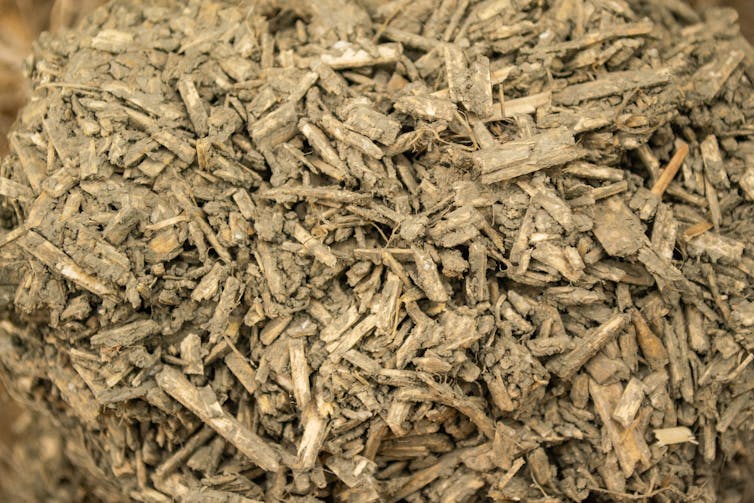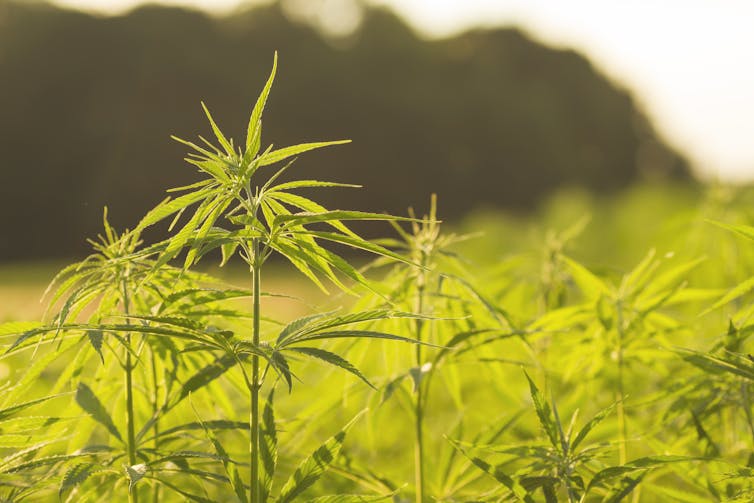Hemp could become a key tool in the fight against climate change. Like timber, hemp is a biogenic material – it’s produced by growing plants. When used to make long-lasting building materials, they provide an effective and low-tech way to reduce carbon emissions because plants absorb carbon dioxide (CO₂) from the atmosphere as they grow. This then gets stored in solid form for the foreseeable future within buildings and cities.
I have estimated that substituting concrete with cross-laminated timber in all new building floor construction globally for the next 30 years, would reduce greenhouse gas emissions by between 20 and 80 million tonnes.
Yet, hemp grows much faster than trees, growing up to four metres within four months, giving it a greater capacity to absorb CO₂ per hectare of farmed land compared to any forest or commercial crop. Industrial hemp can absorb twice as much CO₂ compared to trees, with approximately one hectare of hemp estimated to sequester between eight to 22 tonnes of CO₂ in a year.
Raw hemp fibre can be processed into panels and mats for thermal or acoustic insulation and made into a hemp lime. By mixing raw fibres with mortar and moulding it into blocks, hemp lime can be used as a substitute for concrete blocks in load-bearing walls.

I agree with the argument that biogenic building materials like hemp only delay the inevitable by temporarily absorbing atmospheric greenhouse gases rather than permanently reducing emissions. Any sequestered or stored CO₂ will eventually be released back into the atmosphere when these construction materials and other products reach the end of their life – ideally, after being reused or recycled many times.
But there is real benefit in delaying the rise in atmospheric greenhouse gas concentrations while other mitigation solutions are scaled up around the world. Also, the “embodied carbon” or CO₂e emitted during extraction, transportation and manufacturing stages is lower for hemp-based building materials than for fossil fuel-based materials.
My research into thermal insulation estimates that a 1m² panel of polyisocyanurate (a common synthetic polymer used to insulate roofs and walls) embodies approximately 3.8kg of CO₂e – that’s about 45% more than a hemp insulation panel that transfers heat at the same rate.
Hemp cultivation has direct benefits for the land too. Hemp crops can improve soil health by enhancing activity of soil microorganisms like fungi and nitrogen-fixing bacteria. Hemp’s deep roots help to aerate the soil as they grow and move down into the ground, prevent soil erosion by binding the soil together, reduce soil compaction and enhance overall soil structure and fertility.

Hemp can absorb some toxic chemicals and pollutants from the soil through a process called phytoremediation. It can help clean up contaminated soil by absorbing some heavy metals and other harmful substances, thereby detoxifying the soil. Any resulting contaminated harvest is not suitable as a food product but is ideal for use as a building material.
Hemp typically requires less water than other crops. Its deep root system is efficient at taking up water from the soil so hemp crops don’t require much irrigation. A recent study found that the water footprint of cotton is about three times higher than that of industrial hemp. So hemp can be a sustainable choice, especially in regions prone to drought or water scarcity.
Hemp is naturally resistant to many pests and diseases, so scaling up production of this crop could reduce the amount of pesticide chemicals sprayed onto farmland and potentially polluting waterways.
Hemp renaissance
Hemp seeds are a source of protein, while the stems and leaves have been used to make ropes, clothes and baskets since hemp farming began around 10,000 years ago. But despite its many advantages, hemp went out of fashion.
Hemp production expanded during the modern colonial period due to a increase in demand for boats which were mostly made from wood and hemp. By the late 18th century, hemp consumption started declining in the UK. The increasingly mechanised textile sector created an enormous international demand for cotton bolls (the mature fruit of the cotton plant). As a result, colonial plantations in India and ex-colonies in the newly formed US switched their cultivation from hemp to the more profitable cotton.
The introduction of more durable and versatile synthetic petrochemical-based polymers in the 20th century was another blow to hemp. Propaganda campaigns against hemp eventually culminated in strong legal restrictions to its cultivation.
In 2017, a hemp renaissance began when the US government removed hemp from the controlled substances act. Notably, the crop is still formally classified as a controlled substance in UK, requiring a licence from the Home Office for farming hemp, with ongoing campaigns trying to challenge the status quo.

Modern manufacturing processes now enable raw hemp to compete with petroleum-based polymers in many practical applications, including strong and durable building materials. Unlike synthetic polymers that can release toxic chemicals such as phthalates when they break up in the environment, biogenically sourced materials biodegrade easily without harming the environment.
So, after farming it for thousands of years, hemp is making a comeback onto our plates, clothes and especially into our buildings, ushering in a sustainable revolution in construction practice.
Some hurdles remain. Assuming there is enough available land to meet market demand from competing crops, the higher than average cost of hemp-based building products will likely fall as production scales up. Hemp-based construction technologies are at a very mature stage and perhaps, legislative barriers will be the primary obstacle to a renewed hemp renaissance.
This article appeared here: https://theconversation.com/hemp-is-more-sustainable-than-timber-heres-how-it-could-transform-low-carbon-construction-228341
Dive deep into the world of hemp with PORTAL HEMP by THE HEMP NATION GROUP. Explore curated news feeds on new developments and local news, alongside international hemp headlines. Stay informed and engaged on the latest advancements and issues within the sustainable hemp industry.